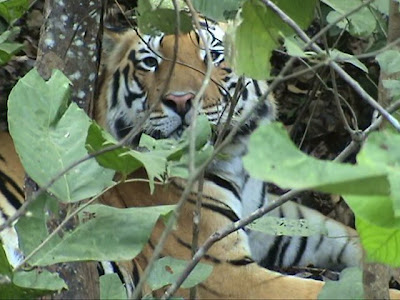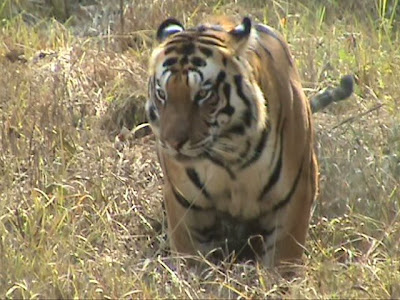The first sight of Ramganga River forced me to call halt! The jeep driver was bit surprised at sudden intrusion into the smooth drive to rest house in Corbett tiger reserve. This was my first visit to Corbett in Uttaranchal a few years back.
With the large stretch of clear blue transparent waters and white stone on the banks - Ramganga river is an enchanting site to behold. I had never seen such beautiful river in my life earlier.
We were on the way to Sarapduli rest house in the core area of the Corbett National park famous for tigers and wild elephants. Sarapduli in my opinion is the best place to stay on a wildlife safari although certainly not star class. The rest house is surrounded on three sides by dense forests and a steep slope in the front which leads to the river bank.
Though silent at day time Sarapduli comes alive to the roars of the tigers and alarm cries of deer in the night time. For a wildlife lover what more? In wee hour of the morning in bitter cold and dense fog a number of Indian birds of come to perch on the surrounding trees and shrubs.
On my first day I photographed basking crocs on river bank. It was one of the best photo shoot I have had of the reptiles. I missed a tiger by a whisker, whence returning from the photo shoot. The pug marks were clearly visible on the damp soil of the trickle from the marshy grasslands. I could see sweat on brows of the accompanying forest guard as he ushered me out of there back to the rest house.
In summers the rest house is crowded by wild elephants and the whole camp is alive in the night. It is feverish with activity in effort to ward off the elephants and there cubs from the premises of the rest house. Elephant watchers visit the park February onwards to see wild elephants that are every where especially in the extensive grasslands.
With the large stretch of clear blue transparent waters and white stone on the banks - Ramganga river is an enchanting site to behold. I had never seen such beautiful river in my life earlier.
We were on the way to Sarapduli rest house in the core area of the Corbett National park famous for tigers and wild elephants. Sarapduli in my opinion is the best place to stay on a wildlife safari although certainly not star class. The rest house is surrounded on three sides by dense forests and a steep slope in the front which leads to the river bank.
Though silent at day time Sarapduli comes alive to the roars of the tigers and alarm cries of deer in the night time. For a wildlife lover what more? In wee hour of the morning in bitter cold and dense fog a number of Indian birds of come to perch on the surrounding trees and shrubs.
On my first day I photographed basking crocs on river bank. It was one of the best photo shoot I have had of the reptiles. I missed a tiger by a whisker, whence returning from the photo shoot. The pug marks were clearly visible on the damp soil of the trickle from the marshy grasslands. I could see sweat on brows of the accompanying forest guard as he ushered me out of there back to the rest house.
In summers the rest house is crowded by wild elephants and the whole camp is alive in the night. It is feverish with activity in effort to ward off the elephants and there cubs from the premises of the rest house. Elephant watchers visit the park February onwards to see wild elephants that are every where especially in the extensive grasslands.
















